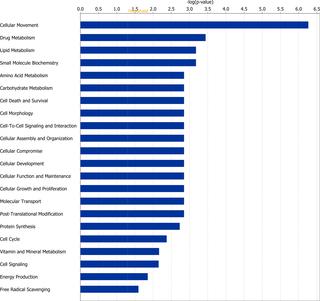PLOS ONE ( IF 2.9 ) Pub Date : 2018-03-19 , DOI: 10.1371/journal.pone.0194445 Kate Keogh , Sinead M. Waters , Paul Cormican , Alan K. Kelly , David A. Kenny

|
Compensatory growth (CG), an accelerated growth phenomenon which occurs following a period of dietary restriction is utilised worldwide in animal production systems as a management practise to lower feed costs. The objective of this study was to evaluate the contribution of jejunal epithelial to CG in cattle through transcriptional profiling following a period of dietary restriction as well as subsequent re-alimentation induced CG. Sixty Holstein Friesian bulls were separated into two groups; RES and ADLIB, with 30 animals in each. RES animals were offered a restricted diet for 125 days (Period 1) followed by ad libitum feeding for 55 days (Period 2). ADLIB animals had ad libitum access to feed across both periods 1 and 2. At the end of each period, 15 animals from each treatment group were slaughtered, jejunal epithelium collected and RNAseq analysis performed. Animals that were previously diet restricted underwent CG, gaining 1.8 times the rate of their non-restricted counterparts. Twenty-four genes were differentially expressed in RES compared to ADLIB animals at the end of Period 1, with only one gene, GSTA1, differentially expressed between the two groups at the end of Period 2. When analysed within treatment (RES, Period 2 v Period 1), 31 genes were differentially expressed between diet restricted and animals undergoing CG. Dietary restriction and subsequent re-alimentation were associated with altered expression of genes involved in digestion and metabolism as well as those involved in cellular division and growth. Compensatory growth was also associated with greater expression of genes involved in cellular protection and detoxification in jejunal epithelium. This study highlights some of the molecular mechanisms regulating the response to dietary restriction and subsequent re-alimentation induced CG in cattle; however the gene expression results suggest that most of the CG in jejunal epithelium had occurred by day 55 of re-alimentation.
中文翻译:

饮食限制和随后的再营养对牛空肠上皮细胞转录谱的影响
补偿性生长(CG)是一种由于饮食限制一段时间而发生的加速生长现象,在全世界范围内被广泛用于动物生产系统中,作为降低饲料成本的管理手段。这项研究的目的是通过一段时间的饮食限制以及随后的再营养诱导的CG来评估空肠上皮对牛CG的贡献,方法是通过转录谱分析。60头荷斯坦黑白花公牛被分为两组。RES和ADLIB,各有30只动物。为RES动物提供限制性饮食125天(时段1),然后随意喂养55天(时段2)。ADLIB动物自由采食在第1阶段和第2阶段都可以采食。在每个阶段结束时,将每个治疗组的15只动物屠宰,收集空肠上皮并进行RNAseq分析。以前限制饮食的动物进行了CG,其获得的速度是非限制动物的1.8倍。在第1期末,与ADLIB动物相比,RES中有24个基因差异表达,只有一个基因GSTA1在第2期结束时,两组之间差异表达。在治疗中(RES,第2期对第1期)进行分析时,饮食限制和进行CG的动物之间有31个基因差异表达。饮食限制和随后的重新营养与参与消化和代谢以及参与细胞分裂和生长的基因表达的改变有关。补偿性生长还与空肠上皮中参与细胞保护和排毒的基因的更高表达有关。这项研究强调了一些调节牛对饮食限制和随后的再营养诱导的CG反应的分子机制。然而,基因表达结果表明,空肠上皮中的大多数CG均在再营养第55天时发生。











































 京公网安备 11010802027423号
京公网安备 11010802027423号